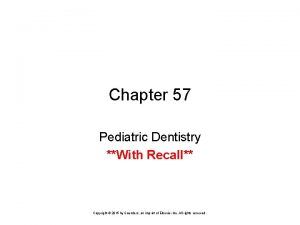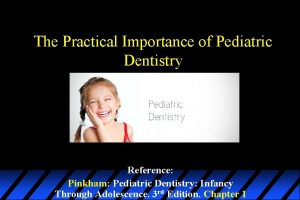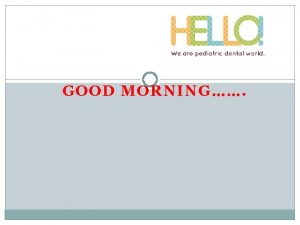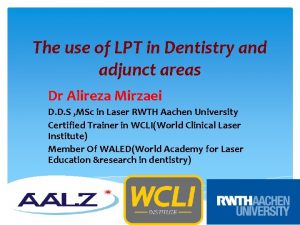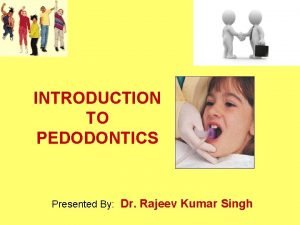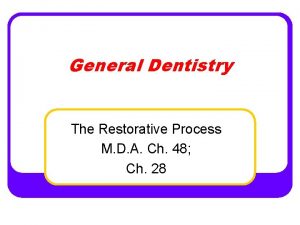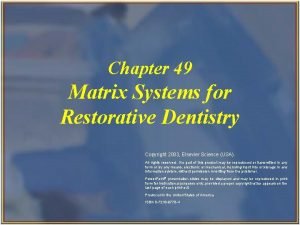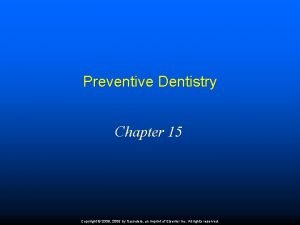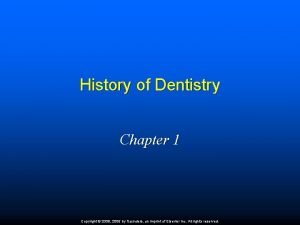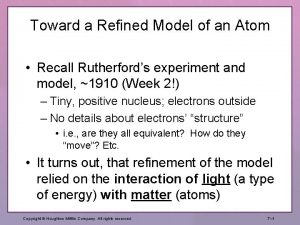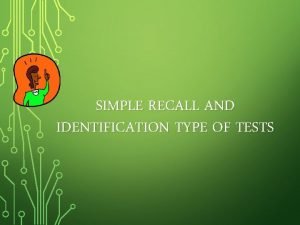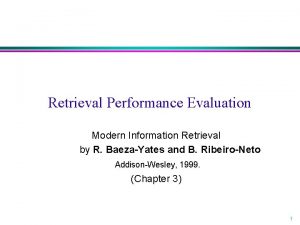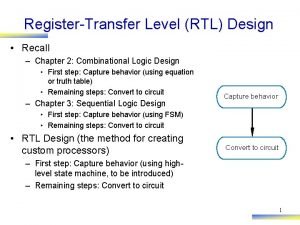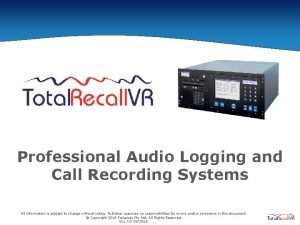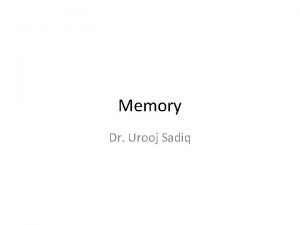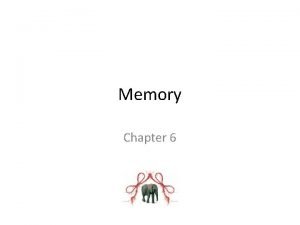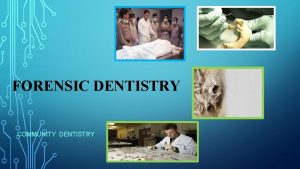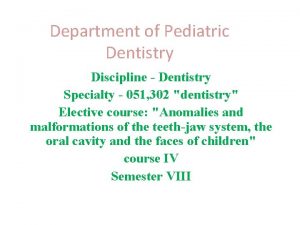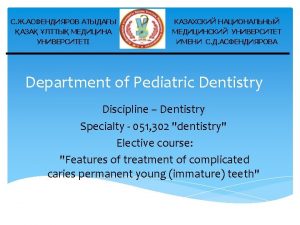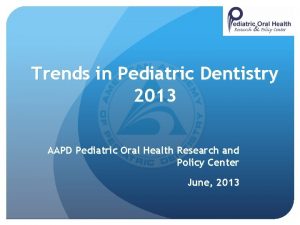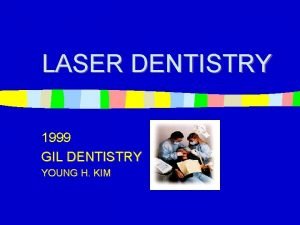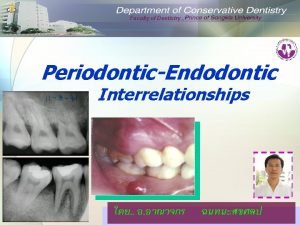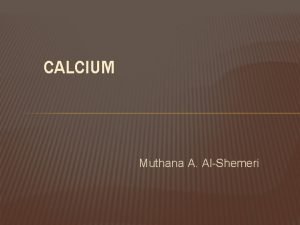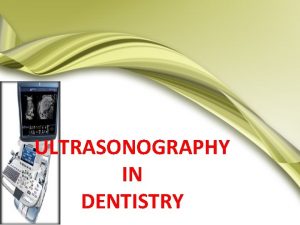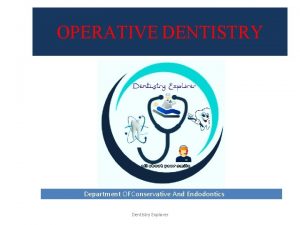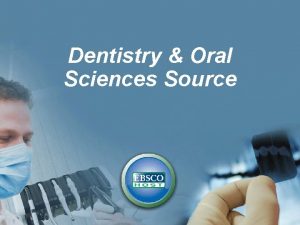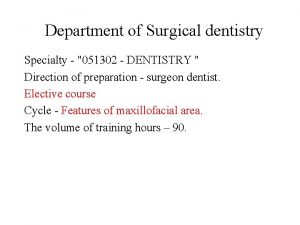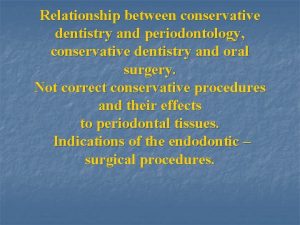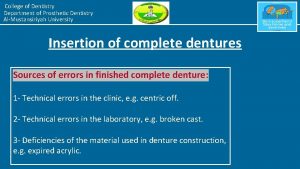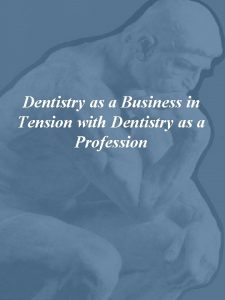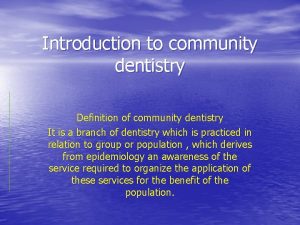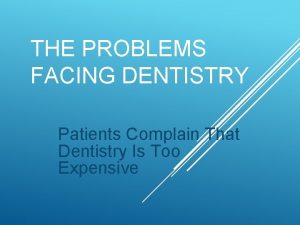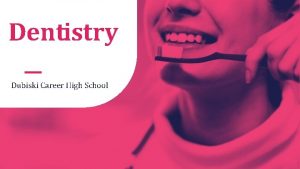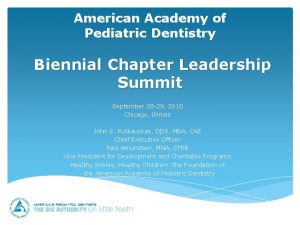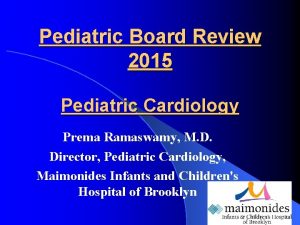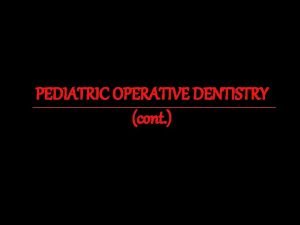Chapter 57 Pediatric Dentistry With Recall Copyright 2015

























- Slides: 25

Chapter 57 Pediatric Dentistry **With Recall** Copyright © 2015 by Saunders, an imprint of Elsevier Inc. All rights reserved.

The Pediatric Dentist A pediatric dentist will continue his or her education for an additional 2 to 3 years after dental school Ø The program of study and hands-on experience prepares the specialist to meet the needs of infants, children, adolescents, and persons with special healthcare needs Copyright © 2015 by Saunders, an imprint of Elsevier Inc. All rights reserved. 2

The Pediatric Patient Chronologic age Ø Mental age Ø The child’s actual age in terms of years and months The child’s level of intellectual capacity and development most important Emotional age The child’s level of emotional maturity Recall #1: Would it be possible to see a 21 y/o patient in a pedo office? Ø Copyright © 2015 by Saunders, an imprint of Elsevier Inc. All rights reserved. 3

The Pediatric Dental Office Treats patients from infants through adolescents as well as special needs Display cheerfulness in a pleasant environment with a nonthreatening décor Treatment areas are designed with an open-bay concept in mind Dental personnel dress in bright coordinating colors Recall # 2: What is unique about the treatment setting of a pediatric office? Recall # 3: What types of patients are seen in a pediatric dental office? Recall # 4: Is it possible for a child to be 10 years old but act 7? If so, what are you describing about this patient? Copyright © 2015 by Saunders, an imprint of Elsevier Inc. All rights reserved. 4

Age & Behavior Management The initial examination is important for both the child and the dental team Children begin to want control and structure ages 3 -5 (“play age”) The rapport developed during the initial examination can establish an attitude toward dental health that will last for a child’s lifetime Many dentists will follow a behavior scale early in the treatment of a pediatric patient ** pg 980** Recall # 5: What developmental stage to children first want control and structure of their environment? Recall # 6: How would Dr. Frankl describe a “positive” child? (pg 980) Copyright © 2015 by Saunders, an imprint of Elsevier Inc. All rights reserved. 5

Guidelines for Child Behavior Be honest with the child Consider the child’s point of view Use “tell, show, do” Give positive reinforcement Copyright © 2015 by Saunders, an imprint of Elsevier Inc. All rights reserved. 6

The Challenging Patient Sedation Ø Nitrous oxide–oxygen Ø This is prescribed to calm the patient and put him or her at ease before treatment This method of mild sedation can help calm a patient for treatment Physical restraint Restraints are used to prevent injury to the child and dental team Recall # 7: When would a “papoose” board be used? (bottom right pg 980) Ø Copyright © 2015 by Saunders, an imprint of Elsevier Inc. All rights reserved. 7

Patients with Special Needs Severely to profoundly mentally challenged children and adults typically undergo dental treatment under general anesthesia in the operating room of a hospital. Patients have limited IQ and adaptive skills. Moderately mentally challenged patients may require sedation or treatment under general anesthesia. Recall #8: What types of skills are limited in a mentally challenged patient? Copyright © 2015 by Saunders, an imprint of Elsevier Inc. All rights reserved. 8

Down Syndrome (Trisomy 21) Eruption of teeth may be delayed, with the primary incisors not erupting until after 1 year of age. Teeth may be small and peg-shaped, often with malocclusion. Periodontal problems are common because of malaligned teeth, mouth breathing, or poor dental care at home. The forward position of the mandible and underdeveloped nasal and maxillary bones do not provide sufficient space for the tongue. The resulting open-mouth, forward-tongue position gives the appearance of an enlarged tongue. Recall # 9: What is another term for Down Syndrome? Copyright © 2015 by Saunders, an imprint of Elsevier Inc. All rights reserved. 9

Autism A developmental disorder that affects how information is processed in the brain by altering how nerve cells and their synapses connect and organize The patient may exhibit behavioral problems with management difficulties Patients who have autism have a known desire for sweet foods and generally have poor oral hygiene which puts them at an increased risk for decay and periodontal disease Copyright © 2015 by Saunders, an imprint of Elsevier Inc. All rights reserved. 10

Cerebral Palsy This nonprogressive neural disorder is caused by brain damage that occurred prenatally, during birth, or postnatally before the central nervous system reaches maturityhe two most Oral hygiene in most patients with cerebral palsy is poor, in part because of the nature of their disease and the resultant physical limitations. The patient and the caregiver should receive a thorough orientation to a home care program, with modifications as necessary to meet the patient’s special needs. Frequently an electric toothbrush can be used effectively. Special adaptations of toothbrush handles and other aids to hygiene also may be helpful Recall # 10: Would it be common to treat a patient with cerebral palsy in a wheelchair? If so, why? Copyright © 2015 by Saunders, an imprint of Elsevier Inc. All rights reserved. 11

Diagnosis and Treatment Planning First appointment should take place around first birthday Regular exams begin at age 2 Parental consent must be given before any dental care is provided for persons under 18 Recall # 11: When should a child first see the dentist? Copyright © 2015 by Saunders, an imprint of Elsevier Inc. All rights reserved. 12

Medical and Dental History Past hospitalizations and surgeries Date of the child’s last visit to a physician Medications, daily medications Unfavorable reactions to any medicine; allergies Weight at birth and any problems at birth Level of learning Main concern about the child’s dental health Finger, thumb, and pacifier habits Fluoride and toothbrush habits Inherited family dental characteristics Copyright © 2015 by Saunders, an imprint of Elsevier Inc. All rights reserved. 13

Initial Clinical Examination Radiographic imaging (to be taken every 6 months for patients at high risk for caries) Extraoral examination Intraoral soft tissue examination Examination and charting of teeth Recall #12: If a patient is at a high risk for decay, how often should radiographs be taken? Copyright © 2015 by Saunders, an imprint of Elsevier Inc. All rights reserved. 14

Preventive Dentistry for Children Oral hygiene Ø Fluorides Ø Ø Efforts are geared to improving a child’s brushing and flossing technique Children between the ages of 6 months and 16 years should take in fluoride daily Fluoride varnish is being used for caries prevention on a routine basis Diet Review the specific nutrients a child needs to grow Recall # 13: Would fluoride varnish be used on a child? Ø Copyright © 2015 by Saunders, an imprint of Elsevier Inc. All rights reserved. 15

Sealants Ø Orofacial development Ø These are applied to pits and fissures to help keep them cavity-free Malocclusions, crowded or crooked teeth, and bite problems must be identified, and the dental staff must intervene (Ex. Appliance to stop thumb sucking as preventative orthodontics) Sports safety Protective equipment should be worn during any recreational sport that might injure the mouth area Recall #14: What procedure is recommended for children to protect the pits and fissures of posterior teeth? Recall #15: Is an appliance that is used to stop a patient from sucking the thumb considered interceptive or preventative orthodontics? Recall # 16: As a swimmer, should you wear a mouth guard? Ø Copyright © 2015 by Saunders, an imprint of Elsevier Inc. All rights reserved. 16

Pediatric Procedures Restorative procedures Ø Ø Endodontic procedures Ø Instrument size Matrix system (T-band spot-welded) Pulpotomy Prosthodontic procedures Stainless steel crown Recall # 17: What types of matrices are commonly used on primary teeth? Recall #18: What endodontic procedure would most likely be done on a primary tooth? Recall #19: Would a child be referred to a prosthodontist for placement of a stainless steel crown? Ø Copyright © 2015 by Saunders, an imprint of Elsevier Inc. All rights reserved. 17

Dental Trauma Fractured anterior teeth Traumatic intrusion Extrusion and lateral luxation injuries Avulsed teeth Recall #20: Which teeth are injured most frequently? Copyright © 2015 by Saunders, an imprint of Elsevier Inc. All rights reserved. 18

Fractured Anterior Teeth Documentation of the accident includes: Ø Ø Ø Clinical examination Radiographs Vitality testing Copyright © 2015 by Saunders, an imprint of Elsevier Inc. All rights reserved. 19

Fractured Anterior Tooth Courtesy Dr. Frank Hodges, Santa Rosa, CA. Copyright © 2015 by Saunders, an imprint of Elsevier Inc. All rights reserved. 20

Avulsed Teeth A tooth is torn away or dislodged completely by force Ø Ø Ø Recover the tooth immediately Wrap the tooth in a moistened gauze Go immediately to the dentist's office Recall #21: What happens when a tooth is avulsed? Copyright © 2015 by Saunders, an imprint of Elsevier Inc. All rights reserved. 21

Avulsion of Maxillary Central Incisors Courtesy Dr. Frank Hodges, Santa Rosa, CA. Copyright © 2015 by Saunders, an imprint of Elsevier Inc. All rights reserved. 22

Extrusion and Lateral Luxation Teeth are displaced from their position, causing damage to the periodontal ligament Displaced teeth are repositioned Ø Often time a splint is used to stabilize teeth while the heal Recall # 22: How would a dentist stabilize a tooth after an injury? Ø Copyright © 2015 by Saunders, an imprint of Elsevier Inc. All rights reserved. 23

Child Abuse Child abuse must be suspected when: Ø Ø Ø Ø Injuries are in various stages of healing Teeth are chipped or injured The child has scars inside the lips or on the tongue and tears of the labial frena The child exhibits battering or other injuries around the head and neck Facial bruises, swelling of the facial structures, or black eyes are evident The child has bite marks Injuries are not consistent with the explanation presented by the parent Copyright © 2015 by Saunders, an imprint of Elsevier Inc. All rights reserved. 24

Child Abuse Recall # 23: Are you as a DA legally required to report child abuse? Recall # 24: Could a fractured or broken nose be a result of child abuse? Recall # 25: Who in the dental office should report child abuse (and is legally required to do so)? Copyright © 2015 by Saunders, an imprint of Elsevier Inc. All rights reserved. 25
 Chapter 57 recall questions
Chapter 57 recall questions Pinkham pediatric dentistry
Pinkham pediatric dentistry Dr br vacher
Dr br vacher Tailwinds pediatric dentistry
Tailwinds pediatric dentistry Father of pediatric dentistry in india
Father of pediatric dentistry in india Copyright 2015 all rights reserved
Copyright 2015 all rights reserved Copyright © 2015 all rights reserved
Copyright © 2015 all rights reserved Chapter 48 general dentistry
Chapter 48 general dentistry Spot welded matrix band
Spot welded matrix band Identify sources of systemic fluoride
Identify sources of systemic fluoride Chapter 1 history of dentistry
Chapter 1 history of dentistry Chapter 49 matrix systems for restorative dentistry
Chapter 49 matrix systems for restorative dentistry 3 step recall method
3 step recall method Recall bias
Recall bias Recall what an atom is.
Recall what an atom is. Identification type example
Identification type example What is a feature article
What is a feature article Woodcock johnson iv subtests
Woodcock johnson iv subtests High precision vs high recall
High precision vs high recall 3 step recall method
3 step recall method Total recall vr
Total recall vr Precision in information retrieval
Precision in information retrieval Oracle total recall
Oracle total recall Recall vs recognition
Recall vs recognition Difference between recall and recognition
Difference between recall and recognition High precision vs high recall
High precision vs high recall
